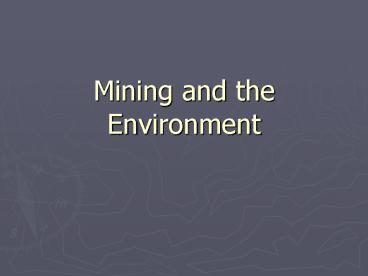Mining and the Environment - PowerPoint PPT Presentation
1 / 17
Title:
Mining and the Environment
Description:
... High-Grade Low-Grade Valuable Minerals and Ore Metallic Minerals Aluminum Steel An alloy of Iron with concentrations of Manganese, ... pollution and environmental ... – PowerPoint PPT presentation
Number of Views:121
Avg rating:3.0/5.0
Title: Mining and the Environment
1
Mining and the Environment
2
Questions for Today
- What is ore and what are examples of useful ores
extracted from the crust? - What are the different ways we extract ore?
- How does mining harm the environment?
- What are some laws that regulate mining and
reclamation?
3
Nonrenewable mineral resources
- Mineral Resources
- A concentration of naturally occurring material
from the earths crust that can be extracted and
processed into useful products. - Fossil Fuels
- Metallic Minerals
- Nonmetallic Minerals
4
Nonrenewable Mineral Resources
- Ores
- A rock that contains a large enough concentration
of a particular mineral to be profitable - Two types
- High-Grade
- Low-Grade
5
Valuable Minerals and Ore
- Metallic Minerals
- Aluminum
- Steel
- An alloy of Iron with concentrations of
Manganese, Cobalt, Molybdenum, and Chromium - Copper
- Platinum
- Gold
- Nonmetallic Minerals
- Sand
- Limestone
- Phosphate salts
6
Methods of Mineral Removal
- Two types of Methods
- Surface Mining
- When gigantic mechanized equipment separate the
overburden, rocks and soil covering the ore, from
the ore. - Subsurface Mining
- When machines and workers mine underground for
seams of ore or other nonrenewable resource.
7
Surface Mining
- Four types of Surface Mining
- Open-pit mining
- Strip Mining
- Contour Mining
- Mountain-top removal
8
Open Pit Mining
- In Open Pit Mining, machines dig holes and remove
ores, sand, gravel, and stone.
9
Strip Mining
- When mineral deposit lie close to earths
surface, the most economical and useful
extraction method is Strip Mining. - Two Types
- Area Strip Mining
- Contour Strip Mining
10
Strip Mining
- Area Strip Mining
- Used when the terrain is flat
- Each new cut is parallel to the previous one.
- Contour Strip Mining
- Use on hilly or mountainous terrain.
- Overburden from each new terrace is dumped onto
the one below.
11
(No Transcript)
12
Mountaintop Removal
- The most drastic type of extraction method.
- Uses dynamite to break apart hard rock to expose
the valuable ore beneath. - Used primarily in the Appalachian Mountains.
13
(No Transcript)
14
Mining environmental Hazards
- Scarring the Land
- Mining destroys land virtually permanently.
- Leaves topsoil degraded and the area wasted
- Land subsiding
- Usually found where subsurface mining takes place
- Wear the land literally caves in
- Cause Water and Air pollution
- Release acids into the water supply and
groundwater
15
Mining Impacts
- Metal ores are smelted or treated with
(potentially toxic) chemicals to extract the
desired metal.
Figure 15-15
16
Natural Capital Degradation
Extracting, Processing, and Using Nonrenewable
Mineral and Energy Resources
Steps
Environmental effects
Mining
Disturbed land mining accidents health hazards,
mine waste dumping, oil spills and blowouts
noise ugliness heat
Exploration, extraction
Processing
Solid wastes radioactive material air, water,
and soil pollution noise safety and health
hazards ugliness heat
Transportation, purification, manufacturing
Use
Noise ugliness thermal water pollution
pollution of air, water, and soil solid and
radioactive wastes safety and health hazards
heat
Transportation or transmission to individual
user, eventual use, and discarding
Fig. 15-10, p. 344
17
Mining Laws
- U.S. General Mining Law of 1872
- Encourages mineral exploration and the mining of
hard rock minerals on US public lands. - Surface Mining Control and Reclamation Act of
1977 - Required Mining Companies to reclaim lands
destroyed by mining.































